
Dive into heartwarming stories that teach acceptance and love with the best transgender books for kids.
Transgender books for kids provide educational and inclusive stories that help children understand gender diversity and foster empathy. Transgender books for kids play a crucial role in promoting acceptance, empathy, and understanding among young readers.
These books offer narratives that resonate with transgender children and help them navigate their complex identities with confidence and knowledge. By featuring diverse and inclusive characters, these books also educate cisgender children about the experiences of their transgender peers. In a society that is becoming increasingly aware of the importance of diversity and inclusivity, these books serve as valuable resources for parents, educators, and caregivers to introduce children to the concept of gender diversity in an age-appropriate and positive manner.
This article explores the significance of transgender books for kids and highlights some recommended titles that can contribute to the nurturing of inclusive values in children.

Credit: www.amazon.com
Exploring Gender Identity
When it comes to teaching children about gender identity, it is important to start early and address the topic in an age-appropriate and inclusive manner. Understanding and accepting gender diversity is crucial for the healthy development of every child, regardless of their own gender identity. By exploring gender identity with children through literature, we can promote inclusivity, acceptance, and empathy. In this section, we will delve into the importance of introducing gender identity to children, understanding gender as a spectrum, and how literature can be a powerful tool in promoting inclusivity and acceptance.
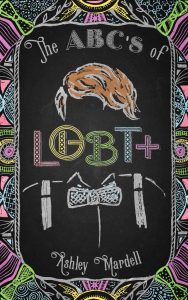
Photo : Amazon
The Importance Of Introducing Gender Identity To Children
Introducing the concept of gender identity to children at a young age is crucial for shaping their understanding of themselves and the world around them. By providing children with the vocabulary to express their feelings and experiences with gender, we empower them to develop a strong sense of self. This early introduction also helps create a safe and supportive environment where children feel comfortable exploring their own gender identities.
Additionally, teaching children about gender identity promotes empathy and understanding towards others. It helps foster a culture of acceptance and respect for diversity, where everyone is valued for who they are. By starting these conversations early, we can contribute to dismantling harmful stereotypes and biases surrounding gender.
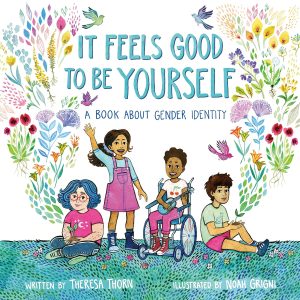
Photo : Amazon
Understanding Gender As A Spectrum
Gender is often understood as a binary concept, with only two categories – male and female. However, it is important to recognize that gender exists on a spectrum, with a wide range of identities beyond the traditional binary. Teaching children about the diversity of gender identities helps challenge these narrow views, enabling them to develop a more nuanced understanding of gender.
Exploring gender as a spectrum also allows children to see that there is no “right” or “wrong” way to be a boy or a girl. It encourages them to question societal norms and expectations, paving the way for a more inclusive and accepting future. By acknowledging and validating gender diversity, we can help children embrace and celebrate their own unique identities as well as those of others.
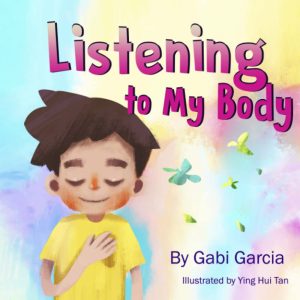
Photo : Amazon
Promoting Inclusivity And Acceptance Through Literature
Children’s literature plays a powerful role in shaping their understanding of the world. By incorporating diverse characters and stories that reflect different gender identities, we can promote inclusivity and acceptance. Through relatable narratives, children are able to connect with characters who may have similar experiences or challenges in navigating their gender identities.
Moreover, literature allows children to develop empathy by providing them with windows into the lives of characters who have diverse gender identities. It can help them recognize the common humanity that exists across gender spectrums and learn to value and respect others’ experiences and identities.
In addition, diverse literature can be a valuable resource for educators and parents who may not have personal experience or knowledge about gender diversity. It provides an opportunity to open up discussions about gender identity, challenging stereotypes, and building a more inclusive community.
In conclusion, exploring gender identity with children is essential for their personal growth and understanding of the world. By introducing gender identity, understanding it as a spectrum, and incorporating diverse literature, we can foster a society that is more inclusive, accepting, and supportive of all individuals.
Empowering Transgender Children
Empowering transgender children is crucial, and one effective way to do so is through transgender books for kids. These books provide important representation and help young readers understand and embrace diverse gender identities.
Recognizing Unique Challenges Faced By Transgender Kids
Transgender children face unique challenges as they navigate their gender identity. From questions and doubts about their own feelings to potential rejection and misunderstanding from peers and family members, it can be an overwhelming journey. Recognizing these challenges is crucial in creating a supportive and understanding environment for transgender kids.
Books specifically written for transgender children are a powerful tool in helping them face these challenges. These books provide insight, understanding, and validation. They enable transgender children to see that they are not alone in their experiences, fostering a sense of belonging and normalizing their gender identity.
Building Self-esteem And Resilience Through Literature
Reading empowering books plays a significant role in building self-esteem and resilience in transgender children. These books not only help them understand and validate their own feelings, but they also depict characters who overcome struggles and find their true selves. By identifying with these characters, transgender children can gain strength, confidence, and a sense of possibility.
Literature has the power to uplift, inspire, and foster empathy. When transgender children see themselves represented in books, it affirms their own experiences and identities. Through empowering narratives, they learn that their gender identity is valid and valuable, boosting their self-esteem and cultivating resilience in the face of adversity.
Highlighting Positive Transgender Role Models In Books
Representation matters, and it is crucial to include positive transgender role models in children’s literature. These role models provide inspiration, guidance, and acceptance for transgender children. By showcasing diverse transgender characters who excel in various areas of life, books become a powerful tool in challenging stereotypes and breaking down societal biases.
Books featuring positive transgender role models allow children to see that being transgender does not limit their potential. They can relate to characters who overcome challenges, pursue their dreams, and make a positive impact on their communities. This representation not only opens doors for transgender children but also helps educate others about transgender experiences, fostering empathy and understanding.

Photo : Amazon
Promoting Acceptance And Empathy
In our diverse and ever-evolving society, promoting acceptance and empathy towards individuals of all gender identities is of paramount importance. When it comes to educating children about transgender issues, using books as a tool can be remarkably effective. Not only do these books foster empathy and understanding in young readers, but they also teach acceptance through relatable characters and stories. Additionally, they encourage open dialogue about gender diversity, allowing children to ask questions and explore these concepts in a safe and supportive environment. Let’s delve into these aspects to see how transgender books for kids can play a crucial role in promoting acceptance and empathy.
Fostering Empathy And Understanding In Young Readers
Transgender books for kids have the incredible potential to foster empathy and understanding in young readers. By introducing characters who identify as transgender or have gender nonconforming experiences, children can develop a deeper sense of compassion and respect for individuals who may be different from themselves. Through engaging narratives, these books help children step into the shoes of these characters and witness their challenges, triumphs, and emotions. This firsthand experience can create a lasting impact and sow the seeds of empathy that will guide them as they interact with transgender individuals in their lives.
Teaching Acceptance Through Relatable Characters And Stories
When children encounter characters in books who share similar experiences or emotions, it becomes easier for them to relate and understand those characters. Transgender books for kids do exactly that by featuring relatable characters and telling stories that reflect the challenges and triumphs faced by transgender individuals. By seeing these characters navigate their journey of self-learning and acceptance, young readers learn the importance of respecting and accepting others for who they are. These stories help break down stereotypes and show that diversity is a beautiful and valuable aspect of our society.
Encouraging Open Dialogue About Gender Diversity
Transgender books for kids play a vital role in encouraging open dialogue about gender diversity. By introducing these topics from an early age, children develop an understanding and familiarity with the concept of gender identity. These books create opportunities for parents, educators, and children to engage in meaningful conversations about gender, difference, and acceptance. The safe space provided by these books allows children to ask questions, express their thoughts and feelings, and broaden their knowledge on the subject. In turn, this open dialogue cultivates an environment of inclusivity, respect, and empathy.
Age-appropriate Transgender Books
When it comes to introducing transgender concepts to kids, it is crucial to select age-appropriate books that are both educational and engaging. By choosing books suitable for different age groups, parents and educators can effectively address common concerns and questions that arise in each stage of a child’s development. In this blog post, we will explore the importance of selecting age-appropriate transgender books for kids and provide guidance on how to introduce transgender concepts through language suitable for each age range.
Selecting Books Suitable For Different Age Groups
Choosing the right transgender books for kids involves considering their developmental stage and understanding their level of comprehension. By aligning the content of the book with their cognitive abilities, children can better grasp the complexities of gender identity in a way that resonates with them.
To simplify the selection process, we have divided the age ranges into three main groups: preschoolers, elementary school children, and middle school students.
Preschoolers
Preschoolers are at a stage where they are forming their understanding of the world around them. Introducing transgender concepts through engaging stories and simple language is key. Look for books that celebrate diversity, promote inclusivity, and feature relatable characters. Some popular choices for this age group include:
- “Red: A Crayon’s Story” by Michael Hall

Photo : Amazon
- “I Am Jazz” by Jazz Jennings and Jessica Herthel
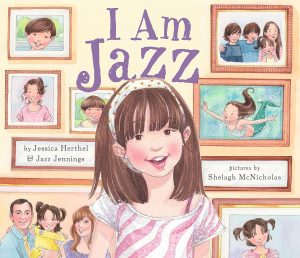
Photo : Amazon
- “Introducing Teddy” by Jessica Walton
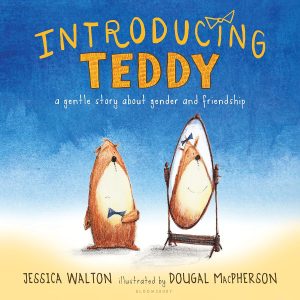
Photo : Amazon
Elementary School Children
As children progress through elementary school, their comprehension skills expand, allowing for more nuanced discussions. Books aimed at this age group can address topics such as gender stereotypes, acceptance, and empathy. Here are some age-appropriate choices for elementary school children:
- “When Aidan Became a Brother” by Kyle Lukoff
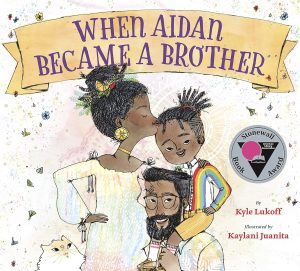
Photo : Amazon
- “George” by Alex Gino

Photo : Amazon
- “They, She, He, Me: Free to Be!” by Maya Christina Gonzalez
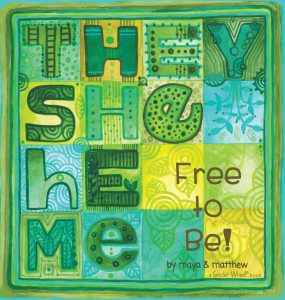
Photo : Amazon
Middle School Students
For middle school students, books can explore more complex themes related to gender identity, discrimination, and self-acceptance. It is important to provide nuanced narratives that touch on social issues while still being relatable. Consider incorporating the following books into their reading list:
- “Being Jazz: My Life as a (Transgender) Teen” by Jazz Jennings
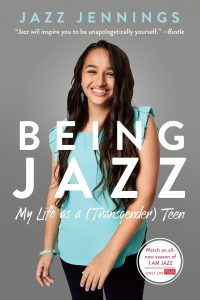
Photo : Amazon
- “This Book is Gay” by Juno Dawson

Photo : Amazon
- “Gracefully Grayson” by Ami Polonsky
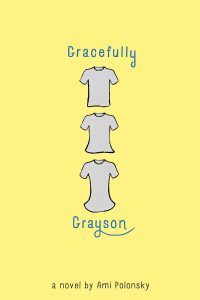
Photo : Amazon
Introducing Transgender Concepts Through Age-appropriate Language
When discussing transgender concepts with children, it is crucial to use age-appropriate language to ensure they can comprehend and engage with the content effectively. Here are a few guidelines to keep in mind when introducing transgender concepts:
- Use simple and straightforward language that resonates with the child’s age group.
- Focus on key elements of gender diversity, such as the importance of respecting others’ identities, rather than delving into complex theoretical frameworks.
- Encourage open and honest conversations, allowing children to ask questions and express their thoughts.
- Emphasize empathy, kindness, and acceptance to create a safe and inclusive environment.
Addressing Common Concerns And Questions For Each Age Range
Throughout a child’s development, they are bound to have questions and concerns about transgender concepts. By addressing these concerns within the context of age-appropriate books, parents and educators can foster understanding and provide support. Here are some common concerns and questions that may arise in each age range:
Preschoolers
- Why do some boys like to wear dresses?
- What does it mean to be transgender?
- Can girls have short hair and boys have long hair?
Elementary School Children
- What if my friend wants to identify as a different gender?
- Why do some people have different pronouns?
- Is it okay for boys to cry and girls to play sports?
Middle School Students
- What challenges do transgender individuals face in society?
- How can we support transgender friends or classmates?
- What does it mean to transition?
By using age-appropriate books that address these concerns, parents and educators can foster a healthy understanding of transgender concepts and promote acceptance and inclusivity.
Resources And Recommendations
When it comes to discussing gender diversity and acceptance with kids, books can be powerful tools. They help to foster understanding, empathy, and inclusivity from an early age. If you’re looking for resources to educate and engage kids on transgender experiences, we’ve curated a list of recommended transgender books. Additionally, we’ve included online resources for parents, educators, and caregivers, along with engaging activities and discussion questions to accompany these books.
Curated List Of Recommended Transgender Books For Kids
If you are searching for books that explore transgender experiences in a age-appropriate and sensitive manner, this curated list will be helpful. Check out the following titles:
| Title | Author | Age Range |
|---|---|---|
| Red: A Crayon’s Story | Michael Hall | 4-8 years |
| Julián Is a Mermaid | Jessica Love | 4-8 years |
| Introducing Teddy: A Gentle Story About Gender and Friendship | Jessica Walton | 3-7 years |
| They, She, He, Me: Free to Be! | Misti Kenison | 3-7 years |
| I Am Jazz | Jessica Herthel & Jazz Jennings | 4-8 years |
Online Resources For Parents, Educators, And Caregivers
When embarking on conversations about transgender experiences, it’s essential to have reliable resources at your fingertips. These online platforms provide valuable information, guidance, and support:
- Gender Spectrum: A website that offers resources and support for families, educators, and professionals.
- GLSEN: A national organization focused on creating safe and affirming schools for LGBTQ+ students. Their website provides resources, toolkits, and educational materials.
- Welcoming Schools: A project of the Human Rights Campaign Foundation that provides professional development, resources, and lesson plans for educators to create LGBTQ+ inclusive schools.
- We Need Diverse Books: An organization dedicated to promoting diverse literature for young readers. Their website offers reading lists and resources that celebrate different identities, including transgender experiences.
Engaging Activities And Discussion Questions To Accompany Books
To maximize the impact of transgender books, engaging activities and thoughtful discussions can further enhance children’s understanding and connection to the material. Here are some activity ideas and discussion questions:
- Draw the Future: Have children draw a picture of their future selves, encouraging them to think beyond gender stereotypes. Ask them to share their drawings and discuss how they see themselves.
- Key Moments: Identify key moments in the book and ask children to act them out or create a skit, allowing them to explore emotions and empathy.
- Discussion Questions: Encourage open conversations with questions like: “How do you think the character felt?”, “Why is it important to accept and support others?”, and “What did you learn from the story?”
- Writing Letters: Provide an opportunity for children to write letters to the characters in the book, expressing their thoughts, understanding, or empathy.
Remember, these activities and questions should be tailored to the age and maturity of the children involved. By combining these resources, recommended books, online platforms, and engaging activities, you can create a safe and inclusive environment for discussing transgender experiences with kids.
Frequently Asked Questions For Transgender Books For Kids
What Are Some Age-appropriate Transgender Books For Kids?
Age-appropriate transgender books for kids include “I Am Jazz” by Jazz Jennings, “Red: A Crayon’s Story” by Michael Hall, and “George” by Alex Gino. These books help children understand gender identity and promote inclusivity and acceptance.
How Can Transgender Books Benefit Children?
Transgender books for kids can benefit children by promoting empathy, understanding, and acceptance of diverse gender identities. They provide a safe and supportive way for children to learn about transgender experiences and foster inclusivity.
Are There Any Transgender Books For Kids That Address Bullying?
Yes, there are transgender books for kids that address bullying. Books such as “Introducing Teddy” by Jessica Walton and “Jacob’s New Dress” by Sarah and Ian Hoffman tackle the topic of bullying and teach kids the importance of empathy and respect for others, regardless of their gender identity.
Are There Transgender Books For Kids That Can Help Parents And Educators?
Absolutely! Transgender books for kids can be valuable resources for parents and educators. Books like “The Transgender Child: A Handbook for Families and Professionals” by Stephanie Brill and Rachel Pepper provide guidance on supporting transgender children and promoting inclusive environments.
Where can I find a PDF of the best transgender books for kids that promote acceptance and empathy?
PDF versions of transgender books for kids promoting acceptance and empathy can often be found on websites dedicated to LGBTQ+ literature, libraries, or online platforms that offer digital books.
Can you recommend some fiction transgender books for kids that focus on acceptance and empathy?
There are many great fiction books for kids that address transgender themes with a focus on acceptance and empathy. Look for titles like “I Am Jazz” by Jazz Jennings and “George” by Alex Gino.
Where can I purchase the best transgender books for kids promoting acceptance and empathy on Amazon?
You can find a wide selection of transgender books for kids promoting acceptance and empathy on Amazon by searching for titles and using relevant keywords such as “transgender children’s books” or “gender identity books for kids.”
Are there gender identity books suitable for 3-5-year-olds?
Yes, there are gender identity books designed for young children aged 3-5. These books use age-appropriate language and illustrations to introduce the concept of gender diversity in a simple and understandable way.
Can you recommend children’s books that focus on LGBTQ+ families and their stories?
Some children’s books about LGBTQ+ families include “And Tango Makes Three” by Peter Parnell and Justin Richardson and “The Family Book” by Todd Parr. These books celebrate the diversity of family structures.
Are there children’s books that specifically address gender identity and gender diversity?
Yes, there are children’s books that directly address gender identity and gender diversity. Look for titles like “The Gender Wheel” by Maya and Matthew, and “It Feels Good to Be Yourself” by Theresa Thorn.
Are there gender identity books suitable for tweens and older children?
Yes, there are gender identity books tailored to tweens and older children, providing a more in-depth exploration of the topic. Books like “The 57 Bus” by Daksha Slater and “Rethinking Normal” by Katie Rain Hill are suitable options.
Are there gender identity books for 2-year-olds?
Gender identity books for 2-year-olds may be limited, but some books can introduce basic concepts of diversity and acceptance. Look for simple board books with inclusive themes that are appropriate for very young children.
Conclusion
These transgender books for kids play a crucial role in fostering understanding, acceptance, and inclusion. Through relatable stories, diverse characters, and age-appropriate language, these books help children learn about gender diversity from an early age. By promoting empathy and respect, they contribute to creating a more inclusive society for all.
So, whether you are a parent, teacher, or caregiver, consider adding these powerful and educational books to your children’s reading list.

Tuhin is a distinguished expert in child development and product development and is a proud alumnus of Dhaka University with a postgraduate degree in child development. As the Product Development Manager at Apparel Village Limited, he skillfully merges his academic background with innovative product strategies, focusing on creating child-friendly and developmentally beneficial products. Tuhin’s unique approach, rooted in child psychology, positions him as a visionary in the industry, continuously contributing to research and setting trends in both child development and product innovation.



